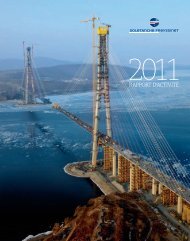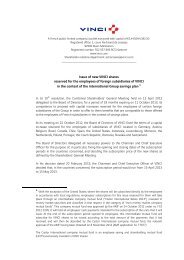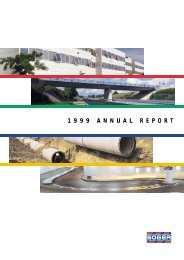VINCI - 2005 annual report
VINCI - 2005 annual report
VINCI - 2005 annual report
Create successful ePaper yourself
Turn your PDF publications into a flip-book with our unique Google optimized e-Paper software.
Provisions for completion losses on contracts and construction project<br />
liabilities are made mainly when end-of-contract projections, based on<br />
the most likely estimated outcome, indicate a loss, and when work needs<br />
to be carried out in respect of completed projects under completion<br />
warranties.<br />
Provisions for disputes connected with operations mainly relate to<br />
disputes with customers, sub-contractors, joint contractors or suppliers.<br />
Restructuring provisions include the cost of plans and measures for which<br />
there is a commitment whenever these have been announced before the<br />
year end.<br />
Provisions for other current liabilities mainly comprise provisions for late<br />
delivery penalties, for individual dismissals and for other risks related to<br />
operations.<br />
Non-current provisions<br />
Non-current provisions are provisions not directly linked to the operating<br />
cycle and that are generally likely to reverse in more than one year.<br />
They include in particular provisions for disputes.<br />
Provisions for major repairs are made in respect of contractual obligations<br />
to return assets operated under concessions to good condition. These are<br />
calculated at the end of each period on the basis of a work programme<br />
covering several years which is reviewed <strong>annual</strong>ly to take account of planned<br />
expenditure.<br />
That part of non-current provisions that matures within less than one year<br />
is shown under current provisions.<br />
Financial debt (current and non-current)<br />
Financial debt comprises bonds and other loans and is recognised at<br />
amortised cost using the effective interest rate method. Under this method,<br />
the redemption premiums and issuance costs, shown as a deduction from<br />
the nominal amount of the liability, are included in the cost of borrowing.<br />
Under this method, the interest expense is recognised actuarially under<br />
the cost of gross financial debt.<br />
This heading also includes the debt component of the OCEANE bonds.<br />
An OCEANE bond is a hybrid instrument that includes a “debt” component<br />
and an “equity” component that corresponds to the option for<br />
conversion into a set number of <strong>VINCI</strong> shares granted to the holder.<br />
In accordance with IAS 32, the issue price of the hybrid instrument is<br />
apportioned between its debt component and its equity component, the<br />
equity component being defined as the difference between the issue price<br />
and the debt component. The debt component corresponds to the fair<br />
value of a debt having the same features but without the conversion option<br />
plus the fair value of issuers’ calls and investors’ puts, if any. The value<br />
attributed to the conversion option is not altered during the term of the<br />
loan. The debt component is measured using the amortised cost method<br />
over its estimated term. Issuance costs are allocated proportionately<br />
between the debt and equity components.<br />
204<br />
<strong>VINCI</strong> <strong>2005</strong> ANNUAL REPORT<br />
The part at less than one year of borrowings is included in current<br />
borrowings.<br />
Fair value of derivative financial instruments<br />
(assets and liabilities)<br />
The Group uses derivative financial instruments to hedge its exposure<br />
to market risks (interest rates, exchange rates, equity prices). Most interest<br />
rate and exchange rate derivatives used by <strong>VINCI</strong> may be considered as<br />
hedging instruments. Recognition as a hedging instrument is applicable if:<br />
– the hedging relationship is clearly defined and documented at the date<br />
when it is set up;<br />
– the effectiveness of the hedging relationship is demonstrated from the<br />
outset, and regularly while it is in place.<br />
Financial instruments considered as hedging instruments<br />
Derivative financial instruments considered as hedging instruments are<br />
systematically recognised in the balance sheet at fair value. Nevertheless,<br />
their recognition varies depending on whether they are considered as:<br />
– a fair value hedge of an asset or liability or of a firm commitment to buy<br />
or sell an asset;<br />
– a cash flow hedge; or<br />
– a hedge of a net investment in a foreign entity.<br />
– Fair value hedge<br />
A fair value hedge enables the exposure to the risk of a change in the fair<br />
value of an asset, a liability such as fixed rate loans and borrowings, assets<br />
and liabilities denominated in foreign currency or firm commitments not<br />
recognised, to be hedged.<br />
Changes in the fair value of the hedging instrument are recognised in<br />
profit or loss for the period. The impact of the revaluation of the hedged<br />
item is recognised symmetrically in profit or loss for the period. Except<br />
for the ineffective part of the hedge, these two revaluations offset each<br />
other within the same line items in the income statement.<br />
– Cash flow hedge<br />
A cash flow hedge allows the exposure to variability in future cash flows<br />
associated with a recognised asset or liability, or a highly probable forecast<br />
transaction, to be hedged.<br />
Changes in the fair value of the derivative financial instrument are recognised<br />
net of tax under equity for the effective part and in profit or loss for<br />
the period for the ineffective part. Cumulative gains or losses in equity<br />
must be reclassified in profit or loss under the same line item as the hedged<br />
item – i.e. under operating income and expenses for cash flows from<br />
operations and under financial income and expense otherwise - whenever<br />
the hedged cash flow affects profit or loss.<br />
If the hedging relationship is interrupted, in particular because it is no<br />
longer considered effective, the cumulative gains or losses in respect of<br />
the derivative instrument are retained in equity and recognised symmetrically<br />
with the cash flow hedged. If the future cash flow is no longer<br />
highly probable, the gains and losses previously recognised in equity are<br />
immediately taken to profit or loss.
















